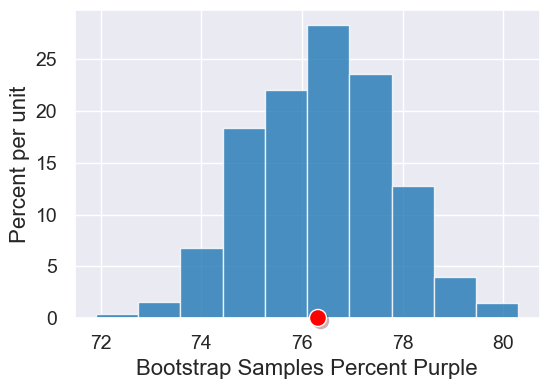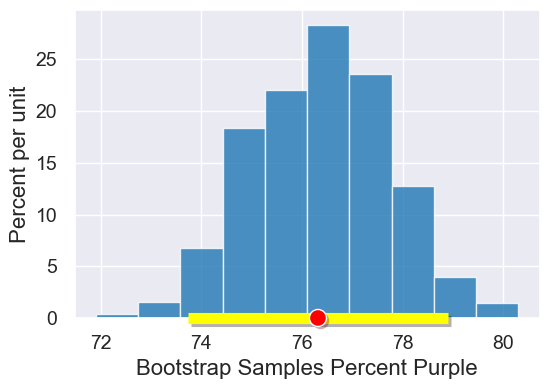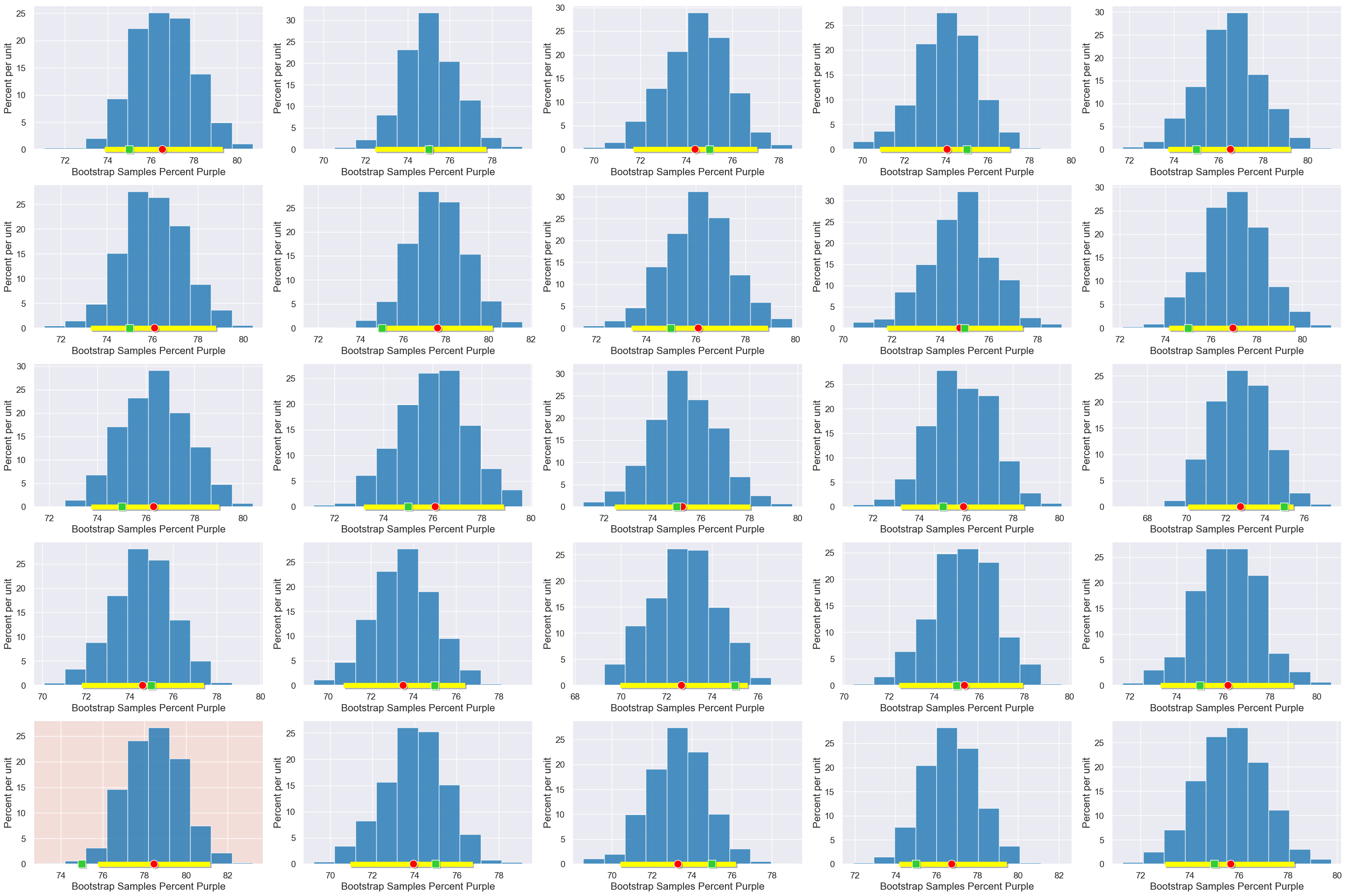Confidence Intervals
Contents
Confidence Intervals#
from datascience import *
from cs104 import *
import numpy as np
%matplotlib inline
1. Pea plants#
Population: all 2nd generation plants
Sample: Mendel’s garden: 929 plants, 709 which had purple flowers
Statistic: Percent Purple
Load Data#
mendel_garden = Table().read_table('data/mendel_garden_sample.csv')
mendel_garden.show(4)
| Plant Number | Color |
|---|---|
| 0 | Purple |
| 1 | Purple |
| 2 | White |
| 3 | White |
... (925 rows omitted)
mendel_garden.num_rows
929
color_array = mendel_garden.column("Color")
Our statistic is the percent purple.
def percent_purple(color):
proportion = sum(color == "Purple") / len(color)
return proportion * 100
observed_stat = percent_purple(color_array)
observed_stat
76.31862217438106
Bootstrapping#
Now we’re ready for our bootstrap_statistic function from our inference library.
results = bootstrap_statistic(color_array, percent_purple, 1000)
table = Table().with_columns("Bootstrap Samples Percent Purple", results)
plot = table.hist("Bootstrap Samples Percent Purple")
plot.dot(observed_stat)

2. Confidence Intervals#
Percentiles#
tiny_purple_stat = make_array(78, 70, 88, 82)
tiny_purple_stat
array([78, 70, 88, 82])
percentile(50, tiny_purple_stat)
78
percentile(75, tiny_purple_stat)
82
Confidence Intervals for Pea Plants#
ci_percent = 95
percent_in_each_tail = (100 - ci_percent) / 2
percent_in_each_tail
2.5
left_end = percentile(percent_in_each_tail, results)
left_end
73.51991388589882
right_end = percentile(100 - percent_in_each_tail, results)
right_end
79.00968783638321
This function, which is also in our inference library, computes the desired confidence interval for an array of statistics.
def confidence_interval(ci_percent, statistics):
"""
Return an array with the lower and upper bound of the ci_percent confidence interval.
"""
# percent in each of the the left/right tails
percent_in_each_tail = (100 - ci_percent) / 2
left = percentile(percent_in_each_tail, statistics)
right = percentile(100 - percent_in_each_tail, statistics)
return make_array(left, right)
ci_95 = confidence_interval(95, results)
ci_95
array([73.51991389, 79.00968784])
table = Table().with_columns("Bootstrap Samples Percent Purple", results)
plot = table.hist("Bootstrap Samples Percent Purple")
plot.interval(ci_95)
plot.dot(observed_stat)

Different Confidence Intervals#
We can use confidence levels other than 95% too! Here is how the level impacts the size of the interval.
Our starting point:
confidence_interval(95, results)
array([73.51991389, 79.00968784])
If we’re okay with less confidence:
confidence_interval(90, results)
array([73.95048439, 78.68675996])
If we want more confidence:
confidence_interval(99, results)
array([72.65877287, 79.76318622])
We can see the impact of confidence level on the width of the interval more easily in the plots below.
def visualize_ci(ci_percent):
"""
Plot the desired confidence interval for our Mendel bootstrap run above.
"""
table = Table().with_columns("Bootstrap Samples Percent Purple", results)
plot = table.hist("Bootstrap Samples Percent Purple")
plot.set_title(str(ci_percent) + "% Confidence Interval")
plot.interval(confidence_interval(ci_percent, results))
plot.dot(observed_stat)
with Figure(1,4, figsize=(5,4)):
visualize_ci(50)
visualize_ci(90)
visualize_ci(95)
visualize_ci(99)

interact(visualize_ci, ci_percent=Slider(0,100,1))
Interpreting Confidence#
Here are 25 runs of our process on random samples. We expect 95% of our runs to produce confidence intervals containing the true parameter (75%).


